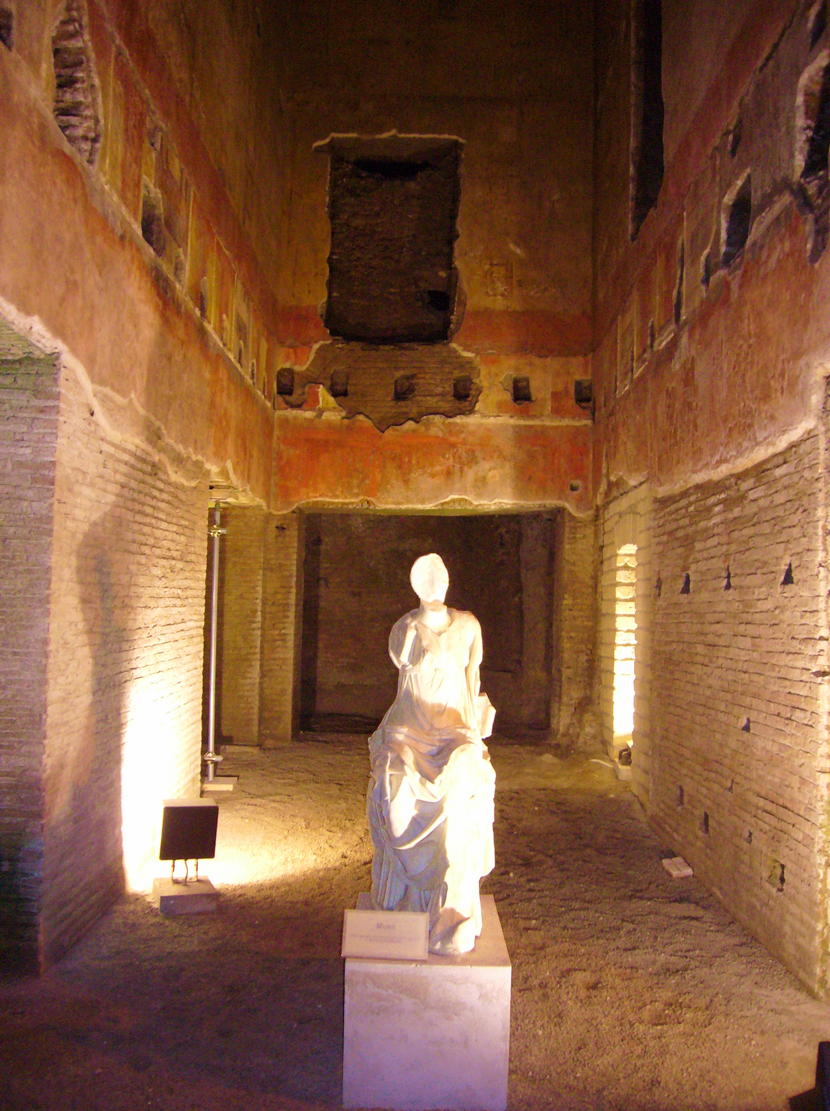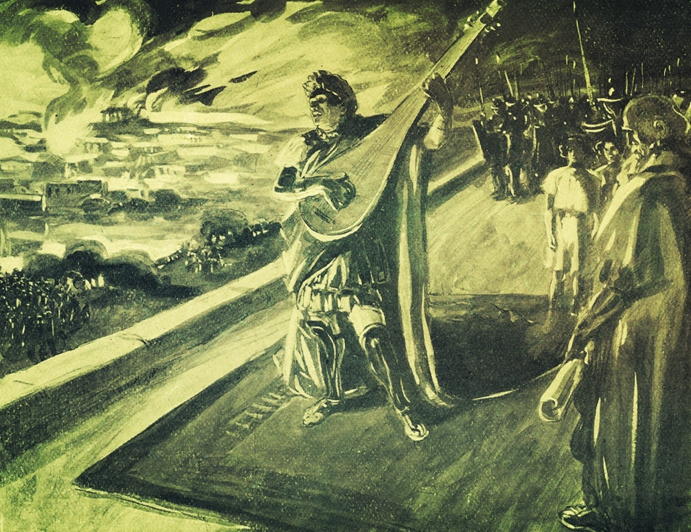House of Gold, House of Passages

Inscribe a riddle on the base of this muse and you’re good to go. (Howard Hudson, CC BY-SA 2.5)
Imagine this: a palace with a triple portico a mile long, stretching between two hills, and the inside covered in jewels, gold, and mother-of-pearl, whose “courtyard was so large that a 120-foot stall colossal statue of the emperor himself stood there. It had…
dining rooms with fretted ceilings whose ivory panels could be turned so that flowers or perfumes from pipes were sprinkled down from above; the main hall of the dining rooms was round, and it would turn constantly day and night like the Heavens…
It sounds like a grand palace from a fantasy novel, something requiring a ton of CGI when the time arrives to film it, but it was a real place in 68 AD. It was the Roman emperor Nero’s Domus Aurea, or Golden House. The Domus Aurea was the second version of his opulent palace. The first, the Domus Transitoria, House of Passages, was destroyed by fire.
There were walls sheathed in polychrome marble, vaults and ceilings covered in vibrant frescoes by the artist Fabullus, and in precious stones, ivory, and gold, and gardens full of masterpieces of sculpture from Greece and Asia Minor.
The space that the palace and its yards used was cleared by the infamous Roman fire of 64 AD; one of the reasons Nero was suspected of causing the fire is that he used the space cleared by the fire to build his extraordinary palace.
That alone is enough to make this golden palace, profiled in the September/October issue of Archaeology magazine worthy of inspiration for a fantasy adventure.
But it turns out to be even more amazing. Nero was horribly disliked. After he died in 68 AD, and the wars for succession settled down, his successors “attempted to obliterate not only the emperor’s memory, but also all traces of the Domus Aurea, and to return to public use, land he had seized for his private projects.”
The 120-foot-tall statue of himself, which was patterned after the Colossus at Rhodes, gave one of the new projects a name: the Colosseum was built atop his artificial lake; the statue itself gained a crown and the new emperor, Vespasian, rededicated it as the Roman sun good Sol.

“From these ashes, I shall build the world’s largest megadungeon.”
After some looting, the palace’s vaulted spaces were filled with earth, and massive public baths were built atop the now-underground palace.
Then the barbarian invaders of the sixth century came along, cut off the water from the aqueducts, and the entire area was abandoned, to be rediscovered in 900 years when some kid, supposedly, fell into it. The fill, having settled, left space to look at the old paintings, and:
Some of the greatest Italian painters, among them Pinturicchio, Ghirlandaio, and Raphael, were lowered by ropes into openings that were originally believed to be caves. Instead, they saw what became the main source of knowledge of the ancient Roman styles of painting that would so heavily influence the art and architecture of the Renaissance.
Later, a public park was built above it, and roots intruded into it, but much of the great vaulted spaces survived.
You think that’s enough? An evil ruler’s forgotten palace underground, directly beneath a public park in the greatest city of the world, ripe for excavation by gnomes or kobolds or some other underground race to build a secret city below the city of the sun above?
If you were to think that’s enough, you would be wrong.
…in the Middle Ages this area became a necropolis for the humble inhabitants of the Oppian Hill. “We have unearthed nine graves that were made using pieces of the cocciopesto from the Trajanic baths,” says Segala. “We have also found traces of agricultural activities, mostly vineyards, orchards, and vegetable gardens, that have damaged the skeletons.”
That’s right. It has undead, too.
A cruel emperor builds a huge palace containing hundreds of rooms on the site of a suspicious fire. The place is gigantic, and everything in it is built on a grand scale. The spinning dining room alone had supporting pillars twelve feet wide.
And after he dies, the palace is buried, abandoned, built over with public baths, abandoned, used as a cemetery, used as farmland, abandoned, and used for public recreation when the once-abandoned city has regrown over it.
It sounds like an urban megadungeon.
- Golden House of an Emperor: Federico Gurgone at Archaeology
- “In no other matter did he act more wasteful than in building a house that stretched from the Palatine to the Esquiline Hill, which he originally named ‘Transitoria’ (House of Passages), but when soon afterwards it was destroyed by fire and rebuilt he called it ‘Aurea’ (Golden House).”
More archaeology
- The strange and marvelous history of the crypt of Balbus
- If you use the real world as your example, there is probably nothing you can’t do in the histories of your adventure locales.
More gaming history
- The Cult of the Cult of Gygax™
- It was never a secret to us back in the day that the staff at TSR played the game themselves, and that they played the game with custom rules and custom worlds.
- Was table-top gaming inevitable?
- Gods & Monsters rolls an 18 for age today, pioneer game writer Greg Stafford died two weeks ago, and stories about the early days of gaming has me wondering, was the discovery of table-top gaming a perfect storm, or was it inevitable?
- The First Language
- Scholars once believed that, or seriously discussed whether, Hebrew was the first language of mankind. In a fantasy game, there really can have been a first, holy language of the gods.
- Currency and economic policy in the middle ages
- Prices, credit, and currencies. If you know the system, you could make a mint!
- The Yuma Territorial Dungeon
- The Yuma Territorial Prison looks like a great dungeon setting. It’s history provides inspirational ideas for more fantastic dungeons.
- 18 more pages with the topic gaming history, and other related pages
More megadungeons
- A legendary ancient manor
- A five-hundred year-old manor built on ancient burial grounds and tied to a mysterious immortal? Where do I sign up?
- Dwimmermount is here!
- The Maliszewski/Macris/Allison 13-level megadungeon has arrived. And it’s 400 pages of maps and craziness.
- The Isle of Mordol
- An island a thousand miles from Specularum, filled with monsters and superstitious townfolk.
